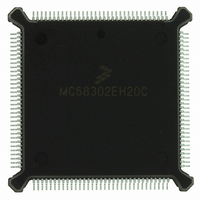MC68302EH20C Freescale Semiconductor, MC68302EH20C Datasheet - Page 272

MC68302EH20C
Manufacturer Part Number
MC68302EH20C
Description
IC MPU MULTI-PROTOCOL 132-PQFP
Manufacturer
Freescale Semiconductor
Datasheets
1.MC68302AG20C.pdf
(4 pages)
2.MC68302AG20C.pdf
(2 pages)
3.MC68302AG20C.pdf
(13 pages)
4.MC68302EH20C.pdf
(481 pages)
Specifications of MC68302EH20C
Processor Type
M683xx 32-Bit
Speed
20MHz
Voltage
5V
Mounting Type
Surface Mount
Package / Case
132-MQFP, 132-PQFP
Family Name
M68000
Device Core
ColdFire
Device Core Size
32b
Frequency (max)
20MHz
Instruction Set Architecture
RISC
Supply Voltage 1 (typ)
5V
Operating Temp Range
0C to 70C
Operating Temperature Classification
Commercial
Mounting
Surface Mount
Pin Count
132
Package Type
PQFP
Lead Free Status / RoHS Status
Lead free / RoHS Compliant
Features
-
Lead Free Status / Rohs Status
Compliant
Available stocks
Company
Part Number
Manufacturer
Quantity
Price
Company:
Part Number:
MC68302EH20C
Manufacturer:
Freescale Semiconductor
Quantity:
10 000
Part Number:
MC68302EH20C
Manufacturer:
FREESCALE
Quantity:
20 000
Company:
Part Number:
MC68302EH20CB1
Manufacturer:
Freescale Semiconductor
Quantity:
10 000
Company:
Part Number:
MC68302EH20CR2
Manufacturer:
Freescale Semiconductor
Quantity:
10 000
- MC68302AG20C PDF datasheet
- MC68302AG20C PDF datasheet #2
- MC68302AG20C PDF datasheet #3
- MC68302EH20C PDF datasheet #4
- Current page: 272 of 481
- Download datasheet (2Mb)
Signal Description
When working with an 8-bit bus (BUSW is low), the data is transferred through the low-order
byte (D7–D0). The high-order byte (D15–D8) is not used for data transfer, but D8-D15 are
outputs during write cycles and are not three-stated.
5.7 BUS CONTROL PINS
The bus control pins are shown in Figure 5-6.
AS—Address Strobe
R/W—Read/Write
UDS/A0—Upper Data Strobe/Address 0
LDS/DS—Lower Data Strobe/Data Strobe
DTACK—Data Transfer Acknowledge
5-8
This bidirectional signal indicates that there is a valid address on the address bus. This
line is an output when the IMP (M68000 core, SDMA or IDMA) is the bus master and is
an input otherwise.
This bidirectional signal defines the data bus transfer as a read or write cycle. It is an out-
put when the IMP is the bus master and is an input otherwise.
This bidirectional line controls the flow of data on the data bus. When using a 16-bit data
bus, this pin functions as upper data strobe (UDS). When using an 8-bit data bus, this pin
functions as A0. When used as A0 (i.e., the BUSW pin is low), then the pin takes on the
timing of the other address pins, as opposed to the strobe timing. This line is an output
when the IMP is the bus master and is an input otherwise.
This bidirectional line controls the flow of data on the data bus. When using a 16-bit data
bus, this pin functions as lower data strobe (LDS). When using an 8-bit data bus, this pin
functions as DS. This line is an output when the IMP (M68000 core, SDMA or IDMA) is
the bus master and is an input otherwise.
This bidirectional signal indicates that the data transfer has been completed. DTACK can
be generated internally in the chip-select logic either for an IMP bus master or for an ex-
ternal bus master access to an external address within the chip-select ranges. It will also
be generated internally during any access to the on-chip dual-port RAM or internal regis-
Figure 5-6. Bus Control Pins
MC68302 USER’S MANUAL
MC68302
AS
DTACK
R/W
UDS / A0
LDS / DS
RMC / IOUT1
IAC
BCLR
MOTOROLA
Related parts for MC68302EH20C
Image
Part Number
Description
Manufacturer
Datasheet
Request
R
Part Number:
Description:
Manufacturer:
Freescale Semiconductor, Inc
Datasheet:

Part Number:
Description:
MC68302 Configuring the Chip Selects on the MC68302
Manufacturer:
Motorola / Freescale Semiconductor

Part Number:
Description:
MC68302 Design Concept - Expanding Interrupts on the MC68302
Manufacturer:
Motorola / Freescale Semiconductor

Part Number:
Description:
MC68302 MC68302 Adapting a WAN Controller to a LAN Environment
Manufacturer:
Motorola / Freescale Semiconductor

Part Number:
Description:
MC68302 EKB Applications - Power Measurements on the MC68302
Manufacturer:
Motorola / Freescale Semiconductor

Part Number:
Description:
MC68302 Interfacing the MC68020 to a Slave MC68302
Manufacturer:
Motorola / Freescale Semiconductor

Part Number:
Description:
MC68302 MC68302 Software Performance
Manufacturer:
Motorola / Freescale Semiconductor

Part Number:
Description:
MC68302 Evaluating EDX on the ADS302
Manufacturer:
Motorola / Freescale Semiconductor

Part Number:
Description:
MC68302 Design Advisory #1 - MC68SC302 Passive ISDN Protocol Engine
Manufacturer:
Motorola / Freescale Semiconductor

Part Number:
Description:
MC68302, MC68360, and MPC860 Characteristics and Design Notes for Crystal Feedback Oscillators
Manufacturer:
Motorola / Freescale Semiconductor
Part Number:
Description:
Mc68302 Integrated Multi-protocol Processor
Manufacturer:
Freescale Semiconductor, Inc
Datasheet:
Part Number:
Description:
Manufacturer:
Freescale Semiconductor, Inc
Datasheet:
Part Number:
Description:
Manufacturer:
Freescale Semiconductor, Inc
Datasheet:
Part Number:
Description:
Manufacturer:
Freescale Semiconductor, Inc
Datasheet:
Part Number:
Description:
Manufacturer:
Freescale Semiconductor, Inc
Datasheet:











